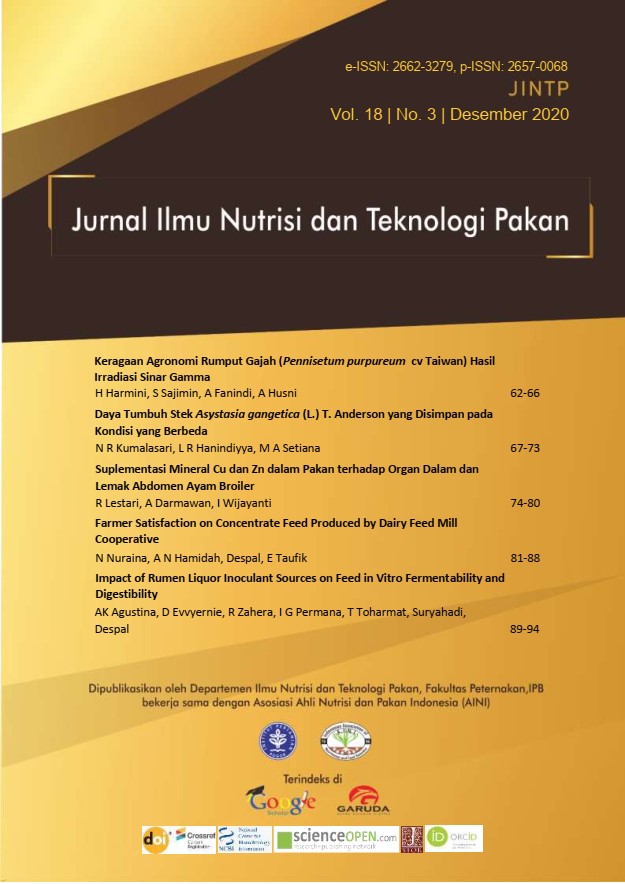Impact of Inoculant Sources on Feed in Vitro Fermentability and Digestibility
Dampak Cairan Rumen Sumber Inokulan pada Fermentabilitas dan Kecernaan Pakan secara In Vitro
Abstract
The aim of this research is to compare alternative inoculant source for in vitro rumen fermentation. In the first experiment, inoculant from fistulated cattle kept in LIPI and IPB (Fis1 and Fis2) and inoculant from Bogor municipality abattoir and IPB abattoir (Abo1 and Abo2) were tested for their pH, total bacterial count, and protozoal number using a complete block design with four replications. In the second experiment, the effect of the inoculant sources was tested on cornmeal (F1), soybean oil meal (F2), Napier grass (F3), and dairy cattle complete ration (F4) fermentability and digestibility including pH, VFA, NH3, IVDMD and IVOMD parameters. The results showed an unsignificant different protozoal number among inoculant sources. The pH of Fis2 rumen liquor was significantly lower (p<0.05) than others. The bacterial population was significantly higher (p<0.05) in Fis2 and Abo2 than Abo1, and Fis1. The inoculant pH after feed fermentability was not influenced by feed type but inoculant source with Fis1 was significantly higher (p<0.05) than Fis2, Abo2, and Abo1. The ammonia, VFA concentration, IVDMD, and IVOMD were influenced by interaction between inoculant sources and feed types. Although inoculant from cattle close to the laboratory (Fis2 and Abo2) were better in term of higher bacterial population, higher fermentability and digestibility for most type of feeds but other sources can be used in vitro study without differences in average fermentability and digestibility results.
Key words: abattoir, fermentability, fistula, inoculant, in vitro
Downloads
Copyright (c) 2020 R Zahera, A K Agustina A K Agustina, D Evvyernie, I G Permana, T Toharmat, Suryahadi, Despal

This work is licensed under a Creative Commons Attribution 4.0 International License.
The authors of the submitted manuscript have to understand and agree that the copyrights published are held by Jurnal Ilmu Nutrisi dan Teknologi Pakan. Copyrights includes rights in reproducing, distributing and selling every section of articles in all forms and media. The copyright transfer form is signed by the corresponding author. The author”
• Creative Commons Attribution (CC BY)
you are allowed to:
Share – copy and redistribute the material in any medium or format
Adapt – remix, transform, and build upon the material
for any purpose, even commercially.
The licensor cannot revoke these freedoms as long as you follow the license terms.
Jurnal Ilmu Nutrisi dan Teknologi Pakan (Nutrition and Feed Technology Journal)

This work is licensed under a Creative Commons Attribution 4.0 International License.












